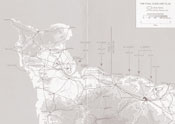 |
|
 |
|
 |
|
|
|
|
|
|
 |
|
D-Day
Airborne and Beach Assault |
|
 |
|
|
|
|
|
|
|
|
|
|
|
|
|
|
|
|
|
|
|
|
|
|
|
|
The
Normandy beaches were chosen by planners because they lay within range of
air cover, and were less heavily defended than the obvious objective of
the Pas de Calais, the shortest distance between Great Britain and the Continent.
Airborne drops at both ends of the beachheads were to protect the flanks,
as well as open up roadways to the interior. Six divisions were to land
on the first day; three U.S., two British and one Canadian. |
|
 |
|
|
|
|
|
 |
|
|
 |
|
|
|
|
|
|
 |
|
|
|
|
 |
|
|
|
|
|
|
|
|
Two
more British and one U.S. division were to follow up after the assault division
had cleared the way through the beach defenses. Disorganization, confusion,
incomplete or faulty implementation of plans characterized the initial phases
of the landings. This was especially true of the airborne landings which
were badly scattered, as well as the first wave units landing on the assault
beaches. To their great credit, most of the troops were able to adapt to
the disorganization. In the end, the Allies achieved their objective. |
|
 |
|
|
|
|
 |
|
|
|
|
|
|
|
|
|
|
|
 |
|
|
|
 |
|
 |
|
|
 |
|
|
|
|
|
|
|
|
|
|
|
|
|
|
|
|
|
|
|
|
|
|
|
|
|
|
|
|
|
|
|
|
|
|
|
Airborne
Assault |
|
|
|
|
|
|
|
|
|
|
|
|
|
|
|
|
|
|
|
|
|
|
|
|
|
|
|
|
|
|
|
|
|
|
|
|
|
|
|
|
|
|
|
|
The
AIRBORNE ASSAULT into Normandy as part of the D-Day Allied invasion of Europe
was the largest use of airborne troops up to that time. Paratroopers of
the U.S. 82d and 101st Airborne divisions, the British 6th Airborne Division,
the 1st Canadian Parachute Battalion, and other attached Allied units took
part in the assault. Numbering more than 13,000 men, the paratroopers were
flown from bases in southern England to the Cotentin Peninsula in approximately
925 C-47 airplanes. An additional 4,000 men, consisting of glider infantry
with supporting weapons and medical and signal units, were to arrive in
500 gliders later on D-Day to reinforce the paratroopers. The parachute
troops were assigned what was probably the most difficult task of the initial
operation -- a night jump behind enemy lines five hours before the coastal
landings.
To protect the invasion zone's western extremity and to facilitate the "Utah"
landing force's movement into the Cotentin Peninsula, the U.S. 82nd and
101st Airborne divisions descended on the peninsula by parachute and glider
in the early hours of D-Day. The paratroopers were badly scattered. Many
were injured and killed during the attack, and much of their equipment was
lost. But the brave paratroopers fought fiercely, causing confusion among
the German commanders and keeping the Germans troops occupied. Their efforts,
hampered by harsh weather, darkness and disorganization, and initiative
of resourceful soldiers and leaders, ensured that the UTAH BEACH assault
objectives were eventually accomplished. The British and Canadian attacks
also accomplished their primary goal of securing the left flank of the invasion
force. |
|
|
 |
 |
| |




